ISSN ONLINE(2319-8753)PRINT(2347-6710)
ISSN ONLINE(2319-8753)PRINT(2347-6710)
Praveen A. Harari1, Akshatha D. S2 and Manavendra.G2
|
| Related article at Pubmed, Scholar Google |
Visit for more related articles at International Journal of Innovative Research in Science, Engineering and Technology
In the present study an experimental work had been carried out to analyze the combustion parameters of B20 neem blend by varying injection pressure and nozzle hole diameter. The engine tests are conducted on kirloskar 4- stroke single cylinder 1500 rpm water cooled direct injection diesel engine with eddy current dynamometer with standard injection timing 23ËšbTDC was maintained constant throughout the experiment. 3 different injection pressures such as 210 bar, 230 bar, 250 bar and 3 different nozzles such as (3×0.28mm), (4×0.23mm), (5×0.20mm) varied to analyze the combustion parameters. From the test results, it could be observed that among 3 different nozzles (3×0.28mm) nozzle gives higher Peak pressure rise as compared to 4 hole nozzle and 5 hole nozzle.
Keywords |
| Neem biodiesel, nozzle, injection pressure, combustion, B20 blend, CI engine. |
INTRODUCTION |
| The world energy demand has been increased drastically in few decades. Firstly, the price of conventional fossil fuel is rising rapidly and has added burden on the pocket of common man and economy of the nations who imports it. Secondly, combustion of fossil fuels is the main reason behind the increasing the carbon dioxide (COâÃâÃâ) level, which results in increase of global warming. The depletion of conventional sources are also becomes the main concern for research world-wide into alternative energy sources for internal combustion engines. Bio-fuels have the potential to become alternative “greener” energy substitute for fossil fuels. It is available in plenty in the world and also the renewable source of energy [1]. Neem oil cannot be used directly in diesel engine because of their high viscosity. The viscosity may cause blockage of fuel lines, filters and results in poor atomization of fuel into the combustion chamber. To reduce the high viscosity of neem oil transesterification reaction has to be done. Biodiesel from neem oil had been a promising alternative for diesel for the future. Nishant Tyagi et al. [1] conducted experiments on neem methyl esters as biodiesel on CI engine and concluded that, B20 blend shows better performance and lower emission characteristics as compared to other blends. L.Prabhu et al. [2] conducted experiments on combustion, performance and emission characteristics of diesel engine with neem oil methyl ester and its diesel blends and concluded that, the performance, combustion and emission characteristics of 20% NOME are better than 100% NOME. Shraddha R.Jogdhankar et al. [3] conducted experiments on alternative fuels and performance of CI engine running on neem oil and biodiesel blends and concluded that B20 blend at 220 bar injection pressure can be used as an alternate for diesel. Dharmendra Yadav et al. [4] conducted experiments on performance parameters of single cylinder four stroke DI diesel engine operating on neem oil biodiesel and its blends and concluded that, neem oil biodiesel BD20, BD50, BD100 are running normal during testing of diesel engine and BD20 blend showed very close performance to diesel. |
METHODOLOGY |
A. TRANSESTERIFICATION PROCESS |
| It is most commonly used and important method to reduce the viscosity of vegetable oils. In this process triglyceride reacts with three molecules of alcohol in the presence of a catalyst producing a mixture of fatty acids, alkyl ester and glycerol. The process of removal of all the glycerol and the fatty acids from the vegetable oil in the presence of a catalyst is called esterification. |
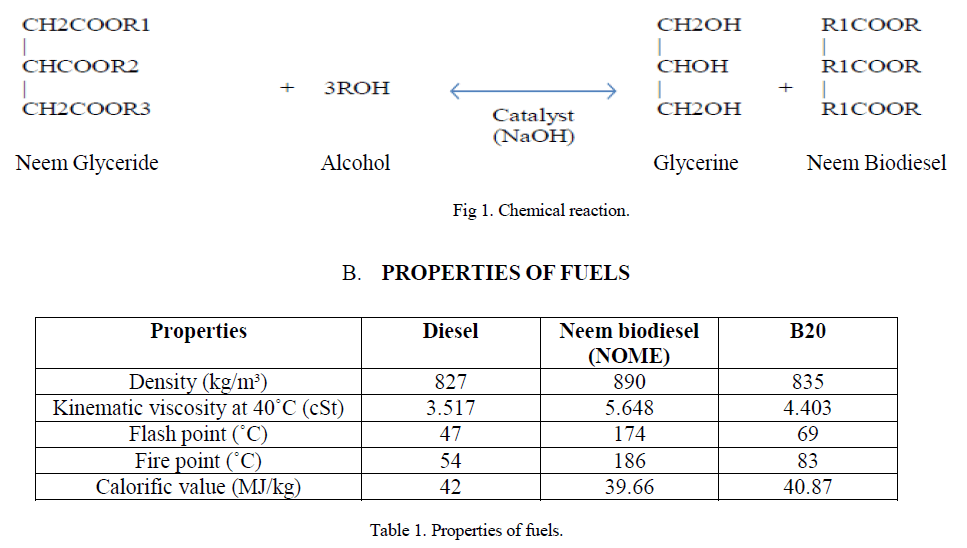 |
C. EXPERIMENTAL SETUP |
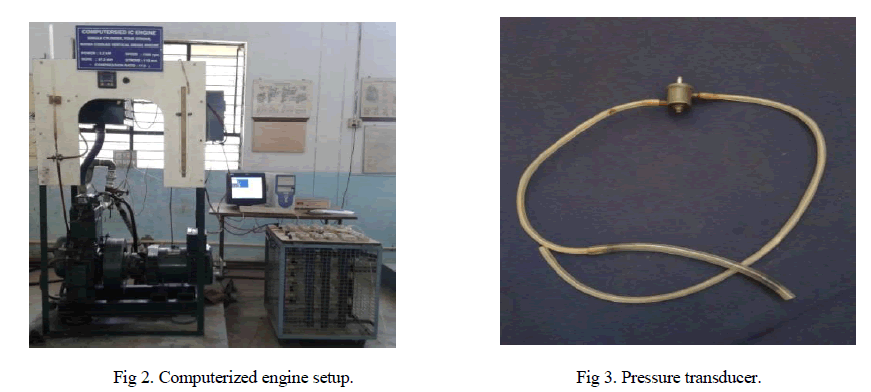 |
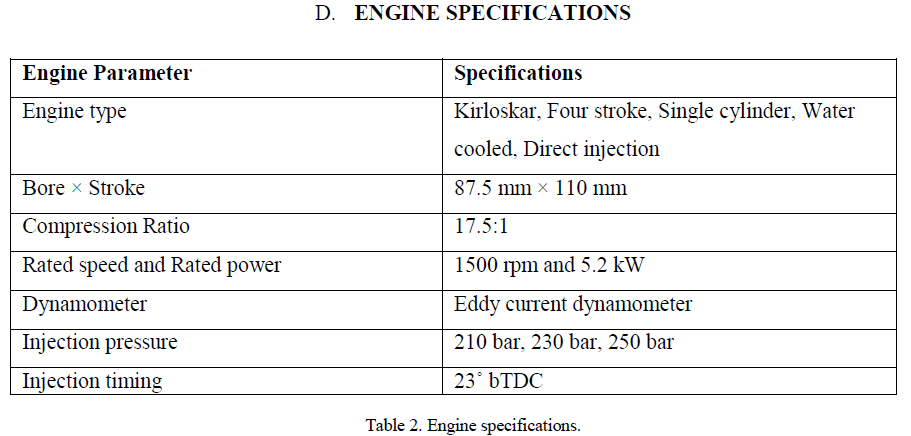 |
| The experiment was carried out to investigate the effect of change in injection pressure and nozzle hole diameter on combustion characteristics of B20 neem blend in a stationary single cylinder diesel engine and to compare it with diesel fuel. Technical specifications of the engine are given above. The engine was coupled with eddy current dynamometer. The engine was operated on diesel first and then on B20 blend of neem methyl ester. The combustion parameters were analyzed from the graphs regarding Peak pressure rise and Indicated mean effective pressure (IMEP) for the blends of B0 and B20. Pressure transducer is used to indicate peak pressure rise and indicated mean effective pressure. For determining the effect of injector nozzle diameter on diesel engine combustion, the number of nozzle holes are increased such as 3 hole, 4 hole and 5 hole. All 3 holes have diameter of 0.28 mm. All 4 holes have diameter of 0.23 mm. All 5 holes have diameter of 0.20 mm. |
E. NOZZLE SPRAY PATTERN |
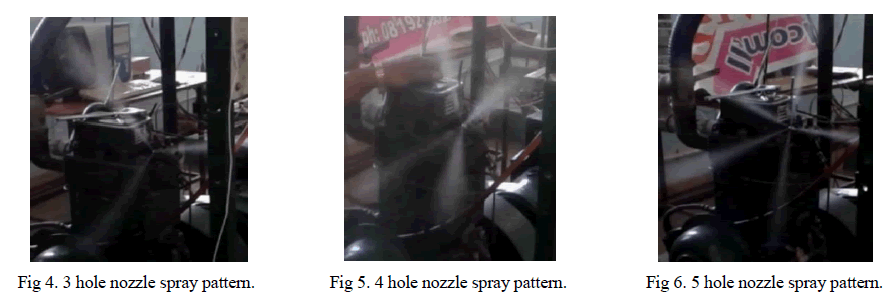 |
RESULTS AND DISCUSSION |
A. PEAK PRESSURE RISE |
| Fig 7. shows the variation of peak pressure rise vs. brake power for 3 hole nozzle at different injection pressures. At all loads, the peak pressure rise of diesel fuel is more than B20 fuel due to lower cetane number and lower heating value of B20 fuel as compared to diesel fuel results in lower cylinder pressure rise for biodiesel [6]. At the time of injection, biodiesel has less air fuel mixture for combustion. The peak pressure rise depends upon premixed combustion phase. Due to premixed combustion phase of burning, lower pressure was obtained for biodiesel blend [7]. For 3 hole nozzle with diesel fuel at 210 bar injection pressure the peak pressure rise were found to be 53.74, 52.39, 57.28, 59.13, 58.12, 57.61 bar at 0.58, 1.17, 1.76, 2.35, 2.94, 3.52 kW of BP respectively. For 3 hole nozzle with B20 fuel at 210 bar injection pressure the peak pressure rise were found to be 49.36, 52.22, 53.74, 55.42, 56.26, 57.11 bar at 0.58, 1.17, 1.76, 2.35, 2.94, 3.52 kW of BP respectively. For 3 hole nozzle with diesel fuel at 230 bar injection pressure the peak pressure rise were found to be 54.11, 57.78, 57.61, 59.63, 55.42, 55.76 bar at 0.58, 1.17, 1.76, 2.35, 2.94, 3.52 kW of BP respectively. For 3 hole nozzle with B20 fuel at 230 bar injection pressure the peak pressure rise were found to be 51.72, 55.59, 55.25, 56.94, 55.09, 54.75 bar at 0.58, 1.17, 1.76, 2.35, 2.94, 3.52 kW of BP respectively. For 3 hole nozzle with diesel fuel at 250 bar injection pressure the peak pressure rise were found to be 53.06, 54.24, 57.95, 58.79, 56.26, 56.1 bar at 0.58, 1.17, 1.76, 2.35, 2.94, 3.52 kW of BP respectively. For 3 hole nozzle with B20 fuel at 250 bar injection pressure the peak pressure rise were found to be 51.38, 54.07, 54.75, 56.77, 55.42, 55.25 bar at 0.58, 1.17, 1.76, 2.35, 2.94, 3.52 kW of BP respectively. |
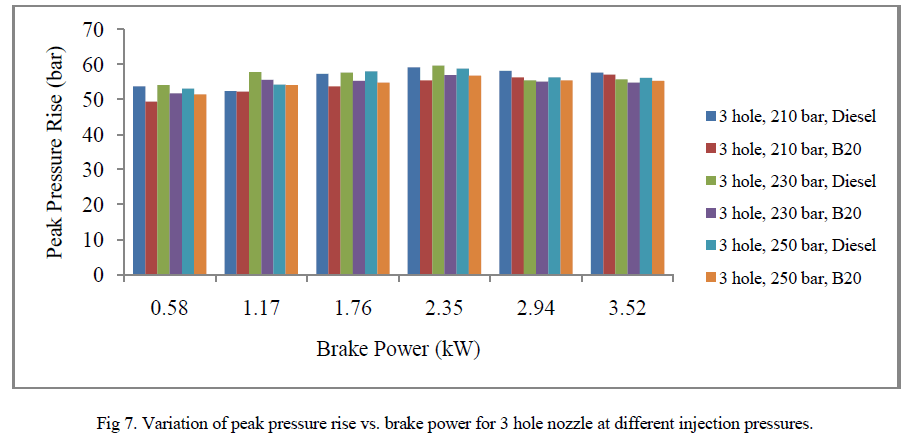 |
| Fig 8. shows the variation of peak pressure rise vs. brake power for 4 hole nozzle at different injection pressures. At all loads, the peak pressure rise of diesel fuel is more than B20 fuel due to lower cetane number and lower heating value of B20 fuel as compared to diesel fuel results in lower cylinder pressure rise for biodiesel [6]. At the time of injection, biodiesel has less air fuel mixture for combustion. The peak pressure rise depends upon premixed combustion phase. Due to premixed combustion phase of burning, lower pressure was obtained for biodiesel blend [7]. For 4 hole nozzle with diesel fuel at 210 bar injection pressure the peak pressure rise were found to be 50.54, 52.39, 49.86, 50.2, 50.71, 49.69 bar at 0.58, 1.17, 1.76, 2.35, 2.94, 3.52 kW of BP respectively. For 4 hole nozzle with B20 fuel at 210 bar injection pressure the peak pressure rise were found to be 48.35, 51.55, 49.36, 49.69, 50.37, 49.02 bar at 0.58, 1.17, 1.76, 2.35, 2.94, 3.52 kW of BP respectively. For 4 hole nozzle with diesel fuel at 230 bar injection pressure the peak pressure rise were found to be 51.21, 52.22, 52.90, 52.05, 52.56, 54.41 bar at 0.58, 1.17, 1.76, 2.35, 2.94, 3.52 kW of BP respectively. For 4 hole nozzle with B20 fuel at 230 bar injection pressure the peak pressure rise were found to be 51.04, 51.38, 51.88, 51.55, 50.54, 52.73 bar at 0.58, 1.17, 1.76, 2.35, 2.94, 3.52 kW of BP respectively. For 4 hole nozzle with diesel fuel at 250 bar injection pressure the peak pressure rise were found to be 49.86, 50.87, 50.37, 50.54, 50.37, 49.86 bar at 0.58, 1.17, 1.76, 2.35, 2.94, 3.52 kW of BP respectively. For 4 hole nozzle with B20 fuel at 250 bar injection pressure the peak pressure rise were found to be 49.86, 50.37, 48.85, 50.03, 49.69, 49.19 bar at 0.58, 1.17, 1.76, 2.35, 2.94, 3.52 kW of BP respectively. |
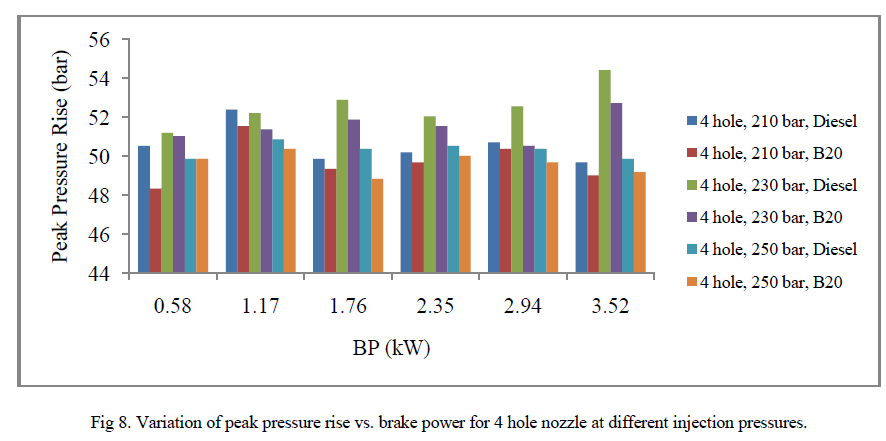 |
| Fig 9. shows the variation of peak pressure rise vs. brake power for 5 hole nozzle at different injection pressures. At all loads, the peak pressure rise of diesel fuel is more than B20 fuel due to lower cetane number and lower heating value of B20 fuel as compared to diesel fuel results in lower cylinder pressure rise for biodiesel [6]. At the time of injection, biodiesel has less air fuel mixture for combustion. The peak pressure rise depends upon premixed combustion phase. Due to premixed combustion phase of burning, lower pressure was obtained for biodiesel blend [7]. For 5 hole nozzle with diesel fuel at 210 bar injection pressure the peak pressure rise were found to be 51.38, 53.74, 54.07, 56.1, 54.07, 53.91 bar at 0.58, 1.17, 1.76, 2.35, 2.94, 3.52 kW of BP respectively. For 5 hole nozzle with B20 fuel at 210 bar injection pressure the peak pressure rise were found to be 49.02, 52.9, 52.9, 55.59, 53.91, 52.73 bar at 0.58, 1.17, 1.76, 2.35, 2.94, 3.52 kW of BP respectively. For 5 hole nozzle with diesel fuel at 230 bar injection pressure the peak pressure rise were found to be 54.41, 53.57, 53.74, 53.23, 55.29, 52.73 bar at 0.58, 1.17, 1.76, 2.35, 2.94, 3.52 kW of BP respectively. For 5 hole nozzle with B20 fuel at 230 bar injection pressure the peak pressure rise were found to be 52.73, 52.05, 53.06, 52.9, 53.06, 52.22 bar at 0.58, 1.17, 1.76, 2.35, 2.94, 3.52 kW of BP respectively. For 5 hole nozzle with diesel fuel at 250 bar injection pressure the peak pressure rise were found to be 53.74, 57.11, 55.25, 53.57, 54.58, 52.56 bar at 0.58, 1.17, 1.76, 2.35, 2.94, 3.52 kW of BP respectively. For 5 hole nozzle with B20 fuel at 250 bar injection pressure the peak pressure rise were found to be 52.73, 53.23, 52.22, 53.4, 52.05, 52.05 bar at 0.58, 1.17, 1.76, 2.35, 2.94, 3.52 kW of BP respectively. |
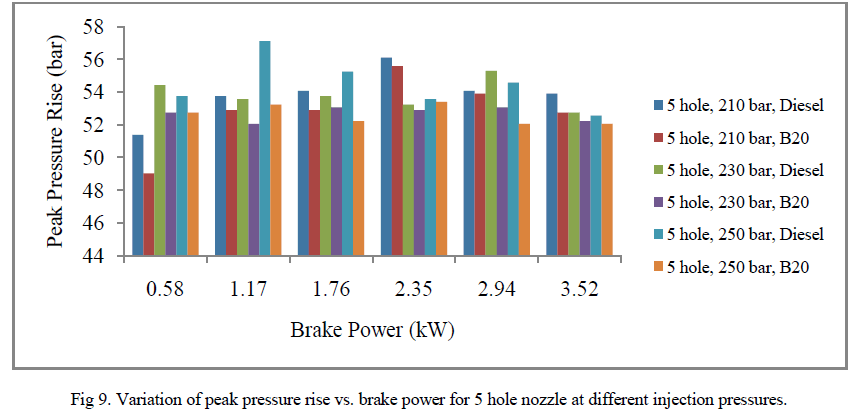 |
B. INDICATED MEAN EFFECTIVE PRESSURE (IMEP) |
| Fig 10. shows the variation of indicated mean effective pressure vs. brake power for 3 hole nozzle at different injection pressures. IMEP increases gradually with increase in BP. For 3 hole nozzle with diesel fuel at 210 bar injection pressure the IMEP were found to be 11.8, 12.41, 13.57, 14.01, 15.09, 15.12 bar at 0.58, 1.17, 1.76, 2.35, 2.94, 3.52 kW of BP respectively. For 3 hole nozzle with B20 fuel at 210 bar injection pressure the IMEP were found to be 11.52, 12.08, 12.77, 13.49, 14.29, 15.65 bar at 0.58, 1.17, 1.76, 2.35, 2.94, 3.52 kW of BP respectively. For 3 hole nozzle with diesel fuel at 230 bar injection pressure the IMEP were found to be 11.98, 12.36, 13.58, 14.09, 14.75, 15.63 bar at 0.58, 1.17, 1.76, 2.35, 2.94, 3.52 kW of BP respectively. For 3 hole nozzle with B20 fuel at 230 bar injection pressure the IMEP were found to be 11.77, 12.57, 13.78, 14.36, 14.74, 15.1 bar at 0.58, 1.17, 1.76, 2.35, 2.94, 3.52 kW of BP respectively. For 3 hole nozzle with diesel fuel at 250 bar injection pressure the IMEP were found to be 12.06, 12.29, 13.45, 14.38, 15.04, 15.4 bar at 0.58, 1.17, 1.76, 2.35, 2.94, 3.52 kW of BP respectively. For 3 hole nozzle with B20 fuel at 250 bar injection pressure the IMEP were found to be 11.79, 12.81, 13.16, 14.2, 14.64, 15.73 bar at 0.58, 1.17, 1.76, 2.35, 2.94, 3.52 kW of BP respectively. |
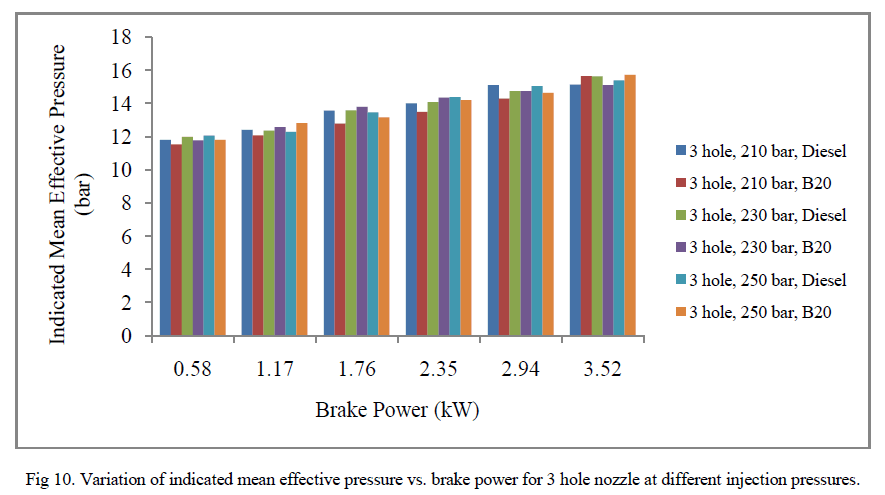 |
| Fig 11. shows the variation of indicated mean effective pressure vs. brake power for 4 hole nozzle at different injection pressures. IMEP increases gradually with increase in BP. For 4 hole nozzle with diesel fuel at 210 bar injection pressure the IMEP were found to be 11.95, 12.63, 12.98, 13.87, 14.44, 15.02 bar at 0.58, 1.17, 1.76, 2.35, 2.94, 3.52 kW of BP respectively. For 4 hole nozzle with B20 fuel at 210 bar injection pressure the IMEP were found to be 11.5, 12.86, 13.47, 14.69, 14.78, 14.85 bar at 0.58, 1.17, 1.76, 2.35, 2.94, 3.52 kW of BP respectively. For 4 hole nozzle with diesel fuel at 230 bar injection pressure the IMEP were found to be 11.64, 12.59, 13.38, 14.41, 14.65, 15.49 bar at 0.58, 1.17, 1.76, 2.35, 2.94, 3.52 kW of BP respectively. For 4 hole nozzle with B20 fuel at 230 bar injection pressure the IMEP were found to be 11.95, 12.81, 13.15, 14.19, 14.24, 15.42 bar at 0.58, 1.17, 1.76, 2.35, 2.94, 3.52 kW of BP respectively. For 4 hole nozzle with diesel fuel at 250 bar injection pressure the IMEP were found to be 11.96, 12.73, 13.47, 14.01, 14.02, 15.54 bar at 0.58, 1.17, 1.76, 2.35, 2.94, 3.52 kW of BP respectively. For 4 hole nozzle with B20 fuel at 250 bar injection pressure the IMEP were found to be 11.55, 12.27, 13.66, 14.09, 14.24, 14.97 bar at 0.58, 1.17, 1.76, 2.35, 2.94, 3.52 kW of BP respectively. |
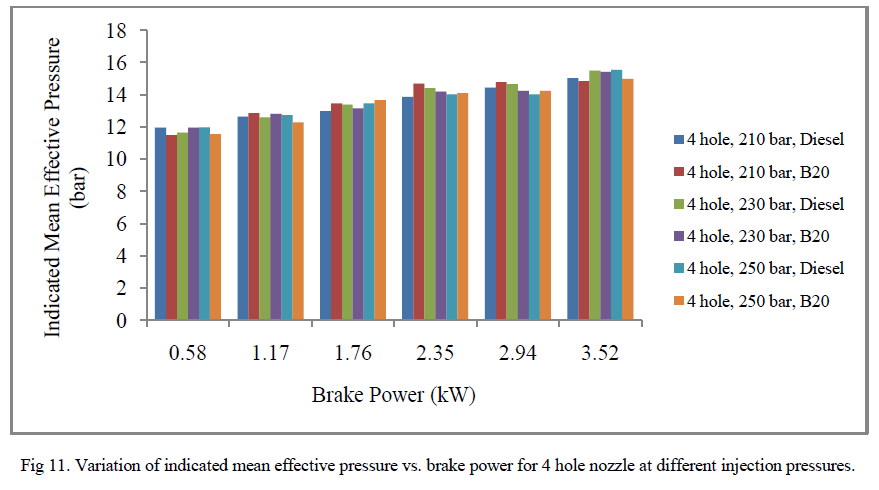 |
| Fig 12. shows the variation of indicated mean effective pressure vs. brake power for 5 hole nozzle at different injection pressures. IMEP increases gradually with increase in BP. For 5 hole nozzle with diesel fuel at 210 bar injection pressure the IMEP were found to be 12.09, 12.62, 13.27, 13.5, 13.91, 15.34 bar at 0.58, 1.17, 1.76, 2.35, 2.94, 3.52 kW of BP respectively. For 5 hole nozzle with B20 fuel at 210 bar injection pressure the IMEP were found to be 11.59, 12.21, 12.93, 14.03, 14.62, 14.85 bar at 0.58, 1.17, 1.76, 2.35, 2.94, 3.52 kW of BP respectively. For 5 hole nozzle with diesel fuel at 230 bar injection pressure the IMEP were found to be 11.69, 12.73, 13.09, 14.09, 14.66, 15.03 bar at 0.58, 1.17, 1.76, 2.35, 2.94, 3.52 kW of BP respectively. For 5 hole nozzle with B20 fuel at 230 bar injection pressure the IMEP were found to be 11.95, 12.09, 13.28, 14.00, 14.87, 15.00 bar at 0.58, 1.17, 1.76, 2.35, 2.94, 3.52 kW of BP respectively. For 5 hole nozzle with diesel fuel at 250 bar injection pressure the IMEP were found to be 12.35, 12.86, 13.42, 14.25, 15.00, 15.46 bar at 0.58, 1.17, 1.76, 2.35, 2.94, 3.52 kW of BP respectively. For 5 hole nozzle with B20 fuel at 250 bar injection pressure the IMEP were found to be 12.52, 13.01, 13.59, 14.2, 14.88, 15.79 bar at 0.58, 1.17, 1.76, 2.35, 2.94, 3.52 kW of BP respectively. |
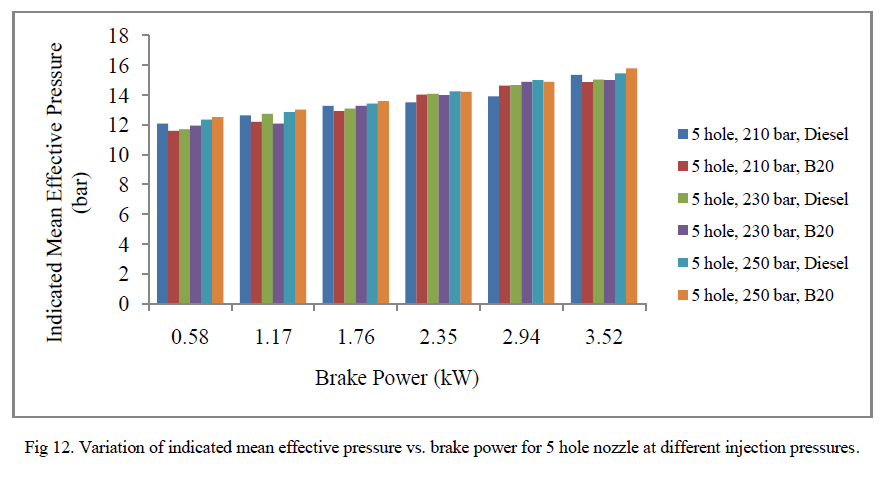 |
P-θ CURVES |
| Fig 13. Shows highest peak pressure rise for 3 hole nozzle with diesel fuel at 210 bar injection pressure. At 210 bar injection pressure for 3 hole nozzle with diesel fuel highest peak pressure rise was found to be 59.13 bar at 2.35 kW of BP. |
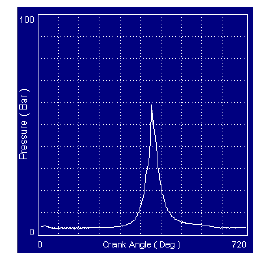 |
| Fig 13. Highest peak pressure rise for 3 hole nozzle with diesel fuel at 210 bar injection pressure. |
| Fig 14. Shows highest peak pressure rise for 3 hole nozzle with diesel fuel at 230 bar injection pressure. At 230 bar injection pressure for 3 hole nozzle with diesel fuel highest peak pressure rise was found to be 59.63 bar at 2.35 kW of BP. |
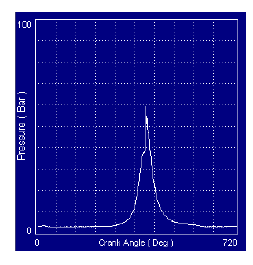 |
| Fig 14. Highest peak pressure rise for 3 hole nozzle with diesel fuel at 230 bar injection pressure. |
| Fig 15. Shows highest peak pressure rise for 3 hole nozzle with diesel fuel at 250 bar injection pressure. At 250 bar injection pressure for 3 hole nozzle with diesel fuel highest peak pressure rise was found to be 58.79 bar at 2.35 kW of BP. |
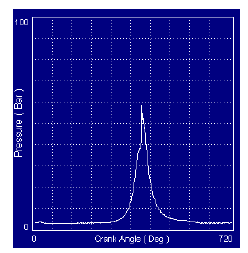 |
| Fig 15. Highest peak pressure rise for 3 hole nozzle with diesel fuel at 250 bar injection pressure. |
| Fig 16. Shows highest peak pressure rise for 3 hole nozzle with B20 fuel at 210 bar injection pressure. At 210 bar injection pressure for 3 hole nozzle with B20 fuel highest peak pressure rise was found to be 57.11 bar at 3.52 kW of BP. |
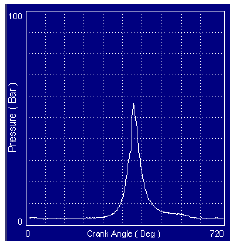 |
| Fig 16. Highest peak pressure rise for 3 hole nozzle with B20 fuel at 210 bar injection pressure. |
| Fig 17. Shows highest peak pressure rise for 3 hole nozzle with B20 fuel at 230 bar injection pressure. At 230 bar injection pressure for 3 hole nozzle with B20 fuel highest peak pressure rise was found to be 56.94 bar at 2.35 kW of BP. |
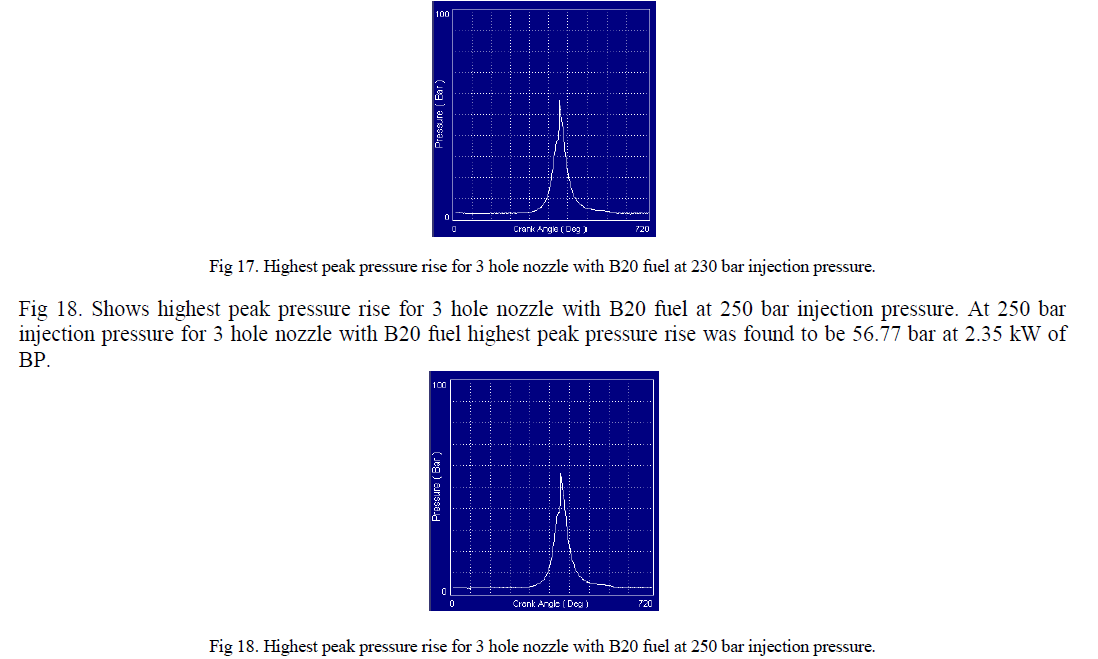 |
| Fig 19. Shows highest peak pressure rise for 4 hole nozzle with diesel fuel at 210 bar injection pressure. At 210 bar injection pressure for 4 hole nozzle with diesel fuel highest peak pressure rise was found to be 52.39 bar at 1.17 kW of BP. |
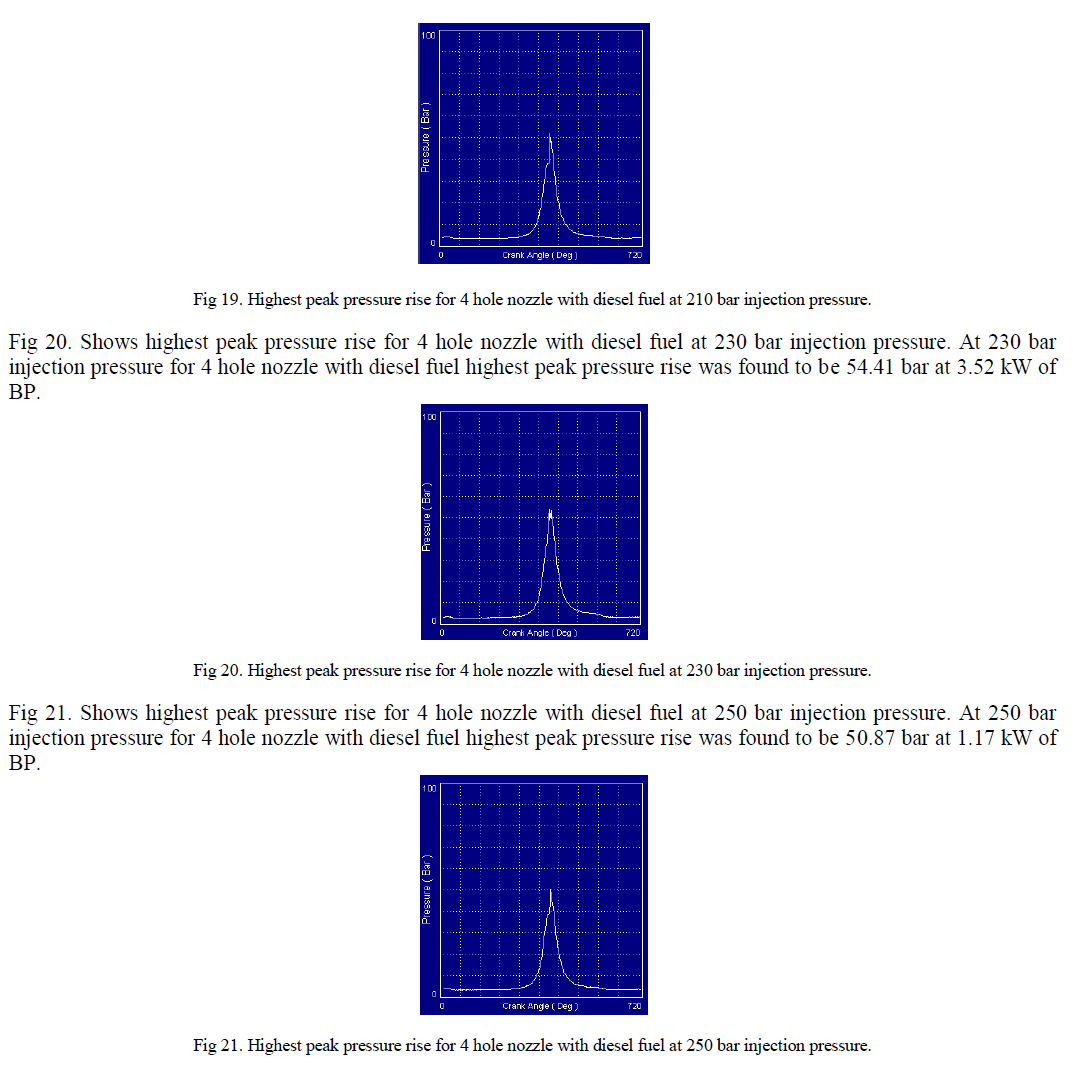 |
| Fig 22. Shows highest peak pressure rise for 4 hole nozzle with B20 fuel at 210 bar injection pressure. At 210 bar injection pressure for 4 hole nozzle with B20 fuel highest peak pressure rise was found to be 51.55 bar at 1.17 kW of BP. |
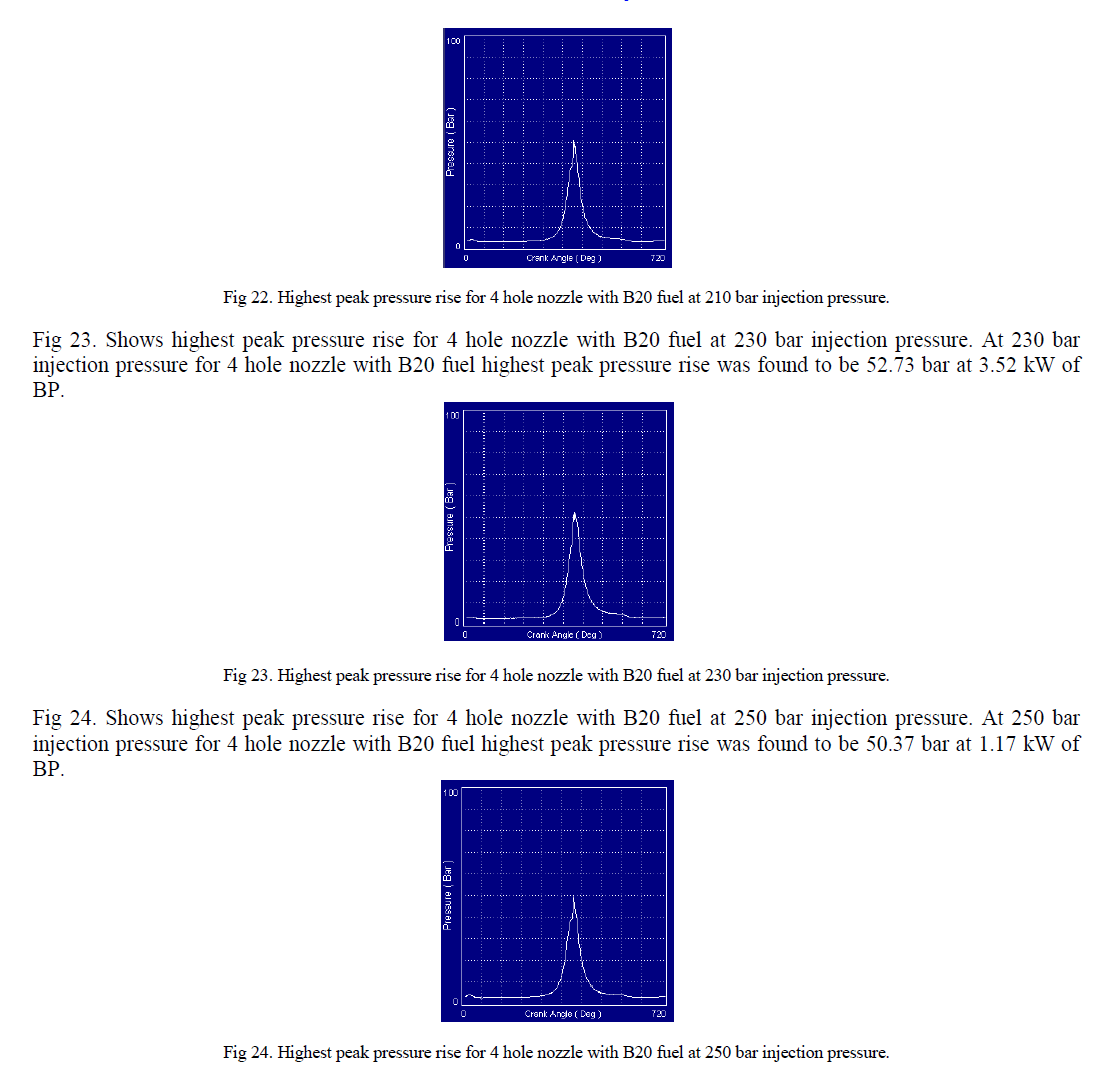 |
| Fig 25. Shows highest peak pressure rise for 5 hole nozzle with diesel fuel at 210 bar injection pressure. At 210 bar injection pressure for 5 hole nozzle with diesel fuel highest peak pressure rise was found to be 56.10 bar at 2.35 kW of BP. |
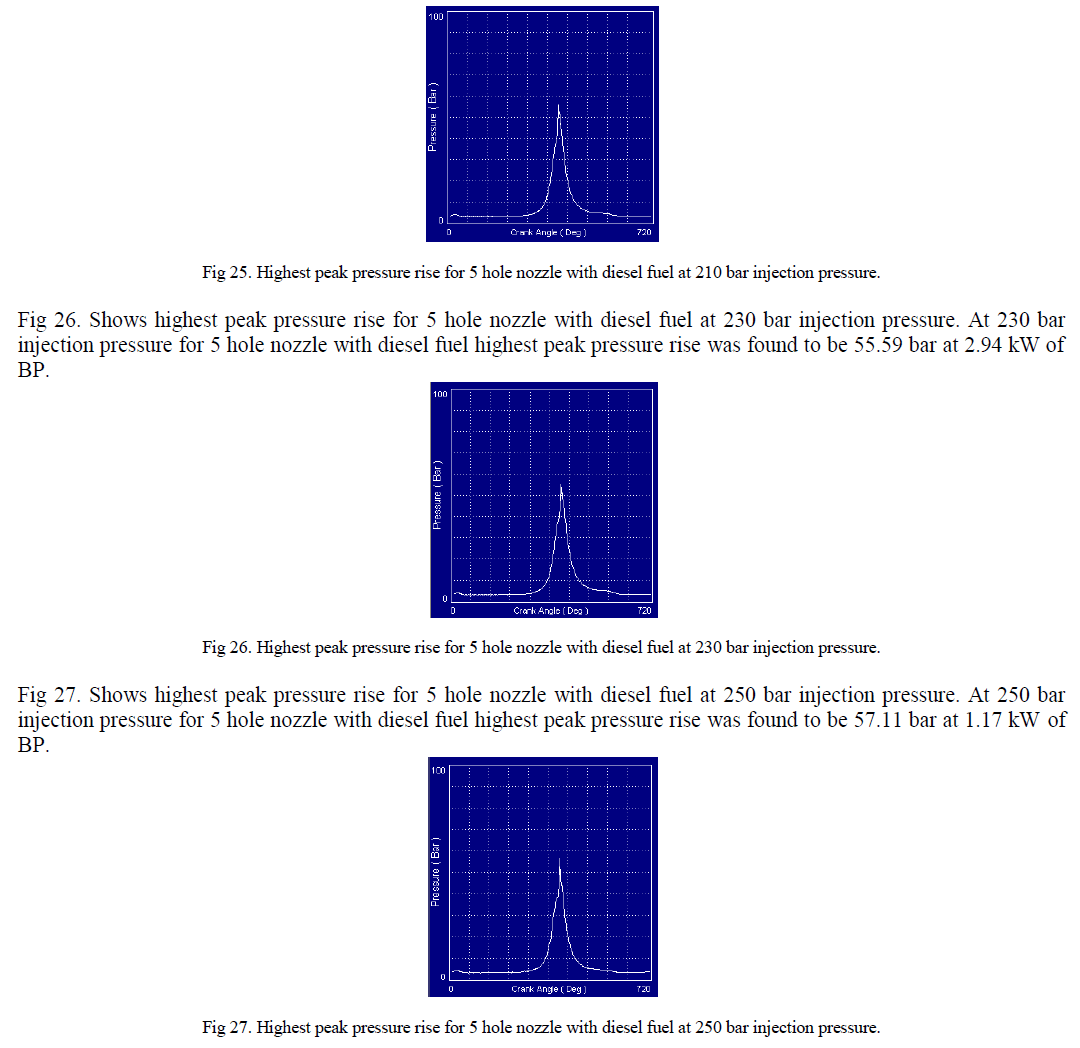 |
| Fig 28. Shows highest peak pressure rise for 5 hole nozzle with B20 fuel at 210 bar injection pressure. At 210 bar injection pressure for 5 hole nozzle with B20 fuel highest peak pressure rise was found to be 55.59 bar at 2.35 kW of BP. |
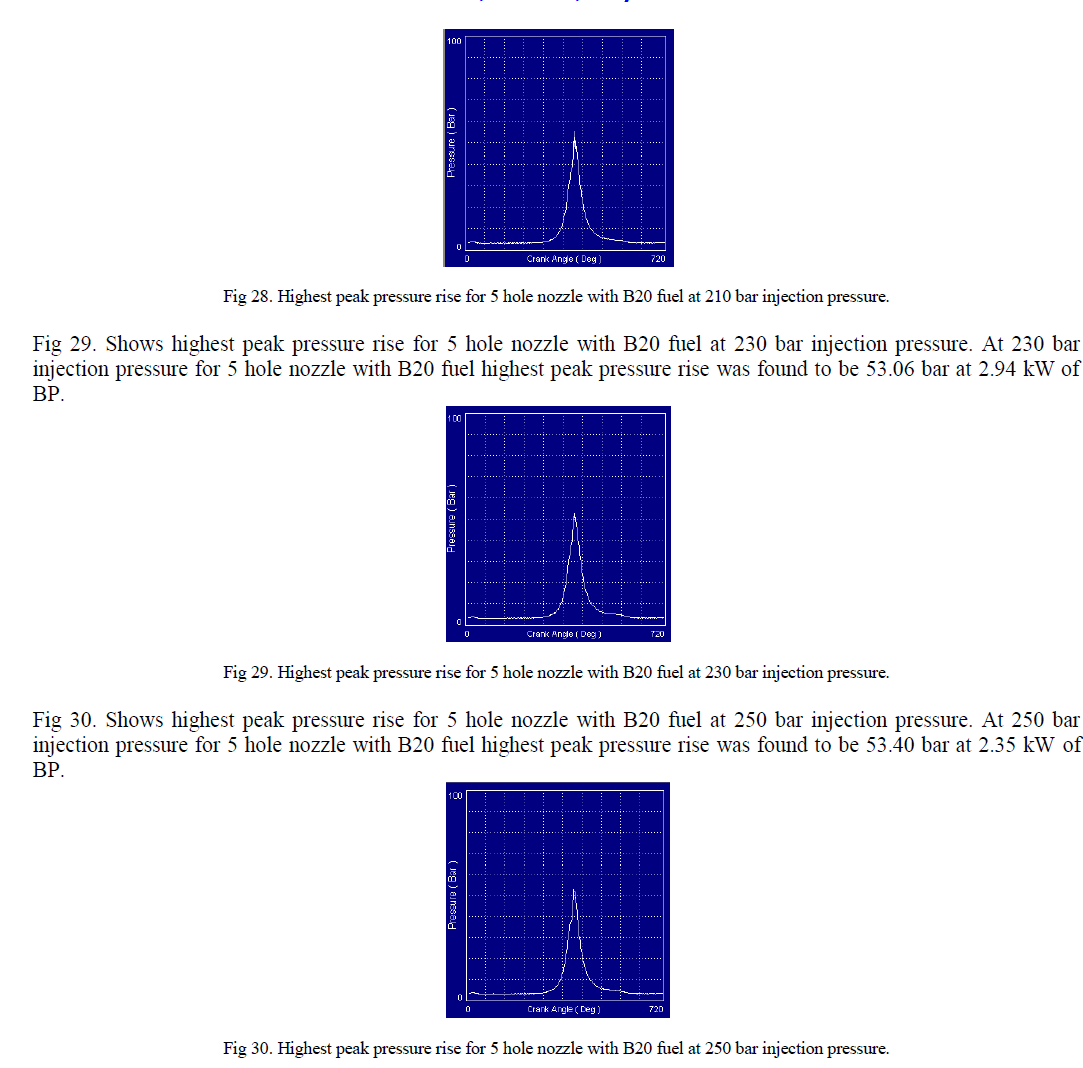 |
CONCLUSION |
| • For 3 hole nozzle, highest Peak pressure rise was found to be 59.63 bar for diesel fuel at 2.35 kW of BP and 230 bar injection pressure, 57.11 bar for B20 fuel at 3.52 kW of BP and 210 bar injection pressure and highest IMEP was found to be 15.63 bar for diesel fuel at 3.52 kW of BP and 230 bar injection pressure, 15.73 bar for B20 fuel at 3.52 kW of BP and 250 bar injection pressure. |
| • For 4 hole nozzle, highest Peak pressure rise was found to be 54.41 bar for diesel fuel at 3.52 kW of BP and 230 bar injection pressure, 52.73 bar for B20 fuel at 3.52 kW of BP and 230 bar injection pressure and highest IMEP was found to be 15.54 bar for diesel fuel at 3.52 kW of BP and 250 bar injection pressure, 15.42 bar for B20 fuel at 3.52 kW of BP and 230 bar injection pressure. |
| • For 5 hole nozzle, highest Peak pressure rise was found to be 57.11 bar for diesel fuel at 1.17 kW of BP and 250 bar injection pressure, 55.59 bar for B20 fuel at 2.35 kW of BP and 210 bar injection pressure and highest IMEP was found to be 15.46 bar for diesel fuel at 3.52 kW of BP and 250 bar injection pressure, 15.79 bar for B20 fuel at 3.52 kW of BP and 250 bar injection pressure. |
References |
|